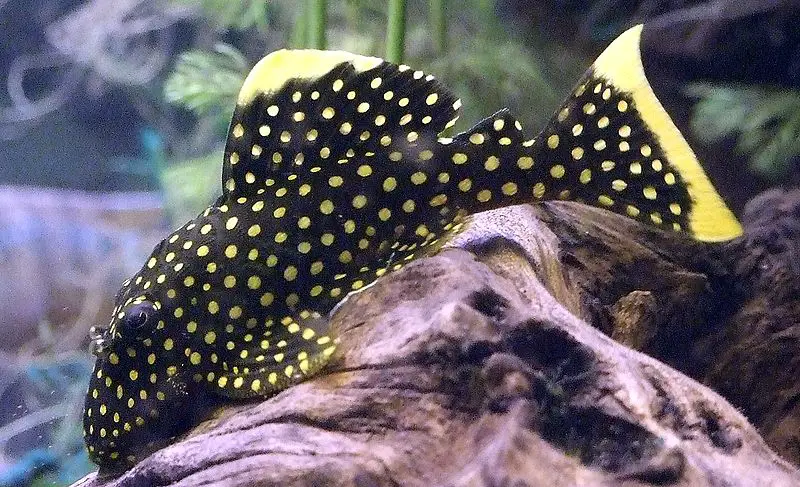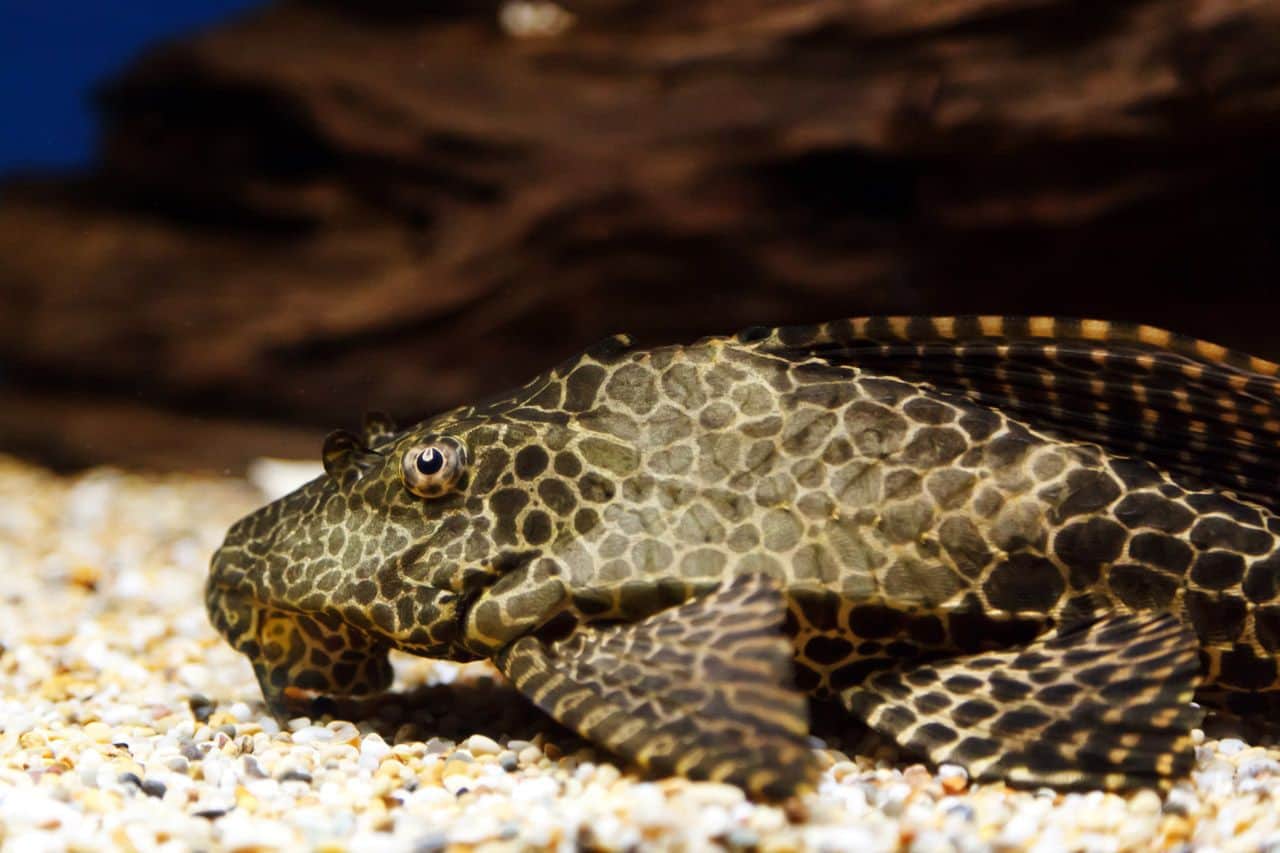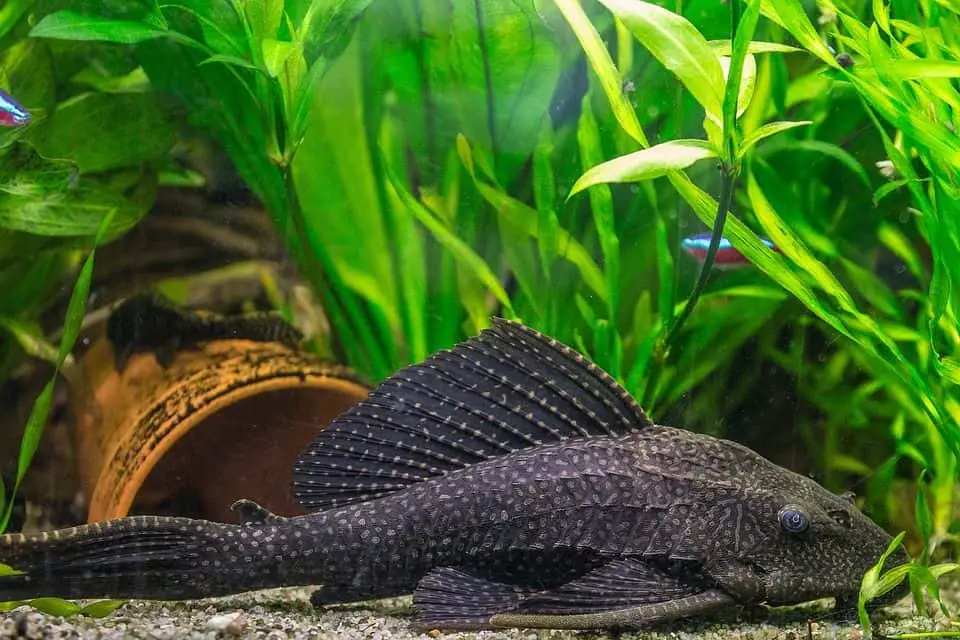I’m not even going to ask if you want a Plecostomus because, well honestly, I know that you do! Everyone loves and wants a Plecostomus. After all, how can you resist that big suckered mouth and long armored body?
The answer is you can’t and you shouldn’t resist them!
Every aquarium needs one of these fantastic guys and the only decision you need to make is which variety your Plecostomus will be?
To help you make this decision, we have prepared this comprehensive guide. Not only to the most popular Plecostomus varieties, but also how to choose one and take care of it.
Here is the ultimate Plecostomus vital care guide!
Table of Contents
Plecostomus: Species Profile
| Scientific Name | Various (Species dependent) |
|---|---|
| Family | Loricariidae |
| Common Name | Armoured catfish, Pleco, Plec, Janitor catfish |
| Origin | Central to South America |
| Lifespan | 10 - 15 years |
| Sociability | Peaceful |
| Growth & Size | Up to 30 inches (species dependent) |
| Diet | Omnivore |
| Suitable foods | Sinking veggie pellets, algae sticks, Flake, Live foods |
| Minimum Tank Size | 30 gallons plus (species dependent) |
| Tank Level | Bottom Dwellers |
| Care Level | Medium |
| Water Parameters | 3-10°dH, 6-8pH, 74-80℉ or 23-27℃ |
| Breeding | Oviparous |
| Good first fish? | Yes |
| Tank Mates | Most freshwater fish and community fish |
| Can you keep two together? | Yes |
| Jumpers? | No, they won’t jump out of your aquarium |
| Recommend Species | Bristlenose Plecos |
| Cost | From $10 depending on size |
When it comes to Plecostomus, there are many species to choose from that have a pattern, color and size to suit everyone and all aquariums. The largest of the Plecostomus is believed to be the Titanic, capable of growth to an amazing 30 inches. The smallest includes the Bristle Nose, a tiny one compared to Titanic, 6 inches tops!
Coming from the Latin for ‘folded mouth’, Plecostomus is easily one of the most popular species in the fish keeping hobby and has been for a long time. This is not only due to their algae eating habits which help keep your aquarium clean, but also because they are magnificently beautiful in their own special way.
What Types Of Plecostomus Are Available?
The Plecostomus is most recognizable by its armor-plated body, suckered mouth and small eyes. The body however, is not completely covered in plating (known as scutes), rather it is devoid of them on its stomach and part of the head. These scutes are thought to be part of the Plecostomuses defense system.
Also part of the Plecostomus defense system are the spines that are found on the dorsal and ventral fin of this fish. These are extended whenever there is a threat present and also to wedge themselves in crevices to avoid being swept away in strong currents.
The fins of the Plecostomus themselves are well developed, with the dorsal having one coarse ray and seven soft. The anal fin by comparison also has one coarse ray but only between 3 – 5 soft. The tail fin is moon-shaped with the bottom part being larger than the top.
Whilst the body shape of a Plecostomus can vary from species to species, they all have one thing in common and that is that they are all rather flat but lengthy. The head is in proportion to the body but can appear to be quite large compared to its small eyes.
With the exception of the Rhinelepini species, all Plecostomus have Omega eyes. They are called this due to their upside-down pupils resembling the Greek letter O. Plecostomus eyes are capable of dilating based on ambient light and also have a membrane that shades them from brighter lights.
Coloration and pattern wise, Plecostomus come in a wide variety, which is not surprising when you consider there are already over 500 species recorded, with more being discovered every year. These include; SailFin, Medusa Head, Rubber Lips, Sunshine, Magnum, Blue Phantom, Royal, Flash, King Tiger and many, many more. There are however, some that are more popular than others such as:
Hypancistrus Zebra – Known as the Zebra Pleco, this species grows to around 3 inches/8 cm and is absolutely stunning. As its name suggests, it is black-and-white striped, with the head stripes running horizontal and the body stripes being vertical. Prices start at around $100.
Baryancistrus Xanthellus – Commonly referred to as the Gold Nugget Pleco, this beauty has a black body with small gold spots covering its entirety. Its dorsal and tail fins also have thick gold edging and it can grow up to 8.6 inches/22 cm. Prices start at around $40.

Ancistrus Cirrhosus – The Bristlenose Pleco is the Marmite of the Plecostomus world with its large bushy whiskers. On the male they are very obvious, whilst on the female they are short and stubby – if present at all. The rest of the Bristlenoses body is dark brown/grey with pale spots and they can grow up to around 6 inches/15 cm. Prices start at around $10.
Hypancistrus Inspector – With its black body which is spattered with vibrant white spots, it is no wonder this gorgeous Plecostomuses common name is the Snowball Pleco. Growing to around 6 inches/15 cm they are a really nice size. Prices start at around $45.
Hypostomus Plecostomus – Referred to as the Common Pleco, this dark brown to grey with black markings Plecostomus is the true giant of home aquariums. It can grow up to a whopping 20 inches/50 cm and requires a huge tank. Prices start at around $10.
Chaetostoma Thomasi – Commonly known as the Rubber Lips Pleco, this 8 inch/20 cm Plecostomus is another beauty. It has a golden body accented by black stripes and a spotted head resembling a crown of jewels. Prices start at around $12.
Where Do Plecostomus Live In The Wild?
Plecostomus are naturally found in the waters of South America including countries such as Brazil, Guiana and Trinidad and Tobago. A few can also be found in Central America; Panama and Costa Rica. They inhabit a variety of water conditions such as fast running mountain streams, soft water brooks, backwaters, and slightly brackish estuaries. Plecostomus are not on the IUCN Red List as they have not been assessed.
More unnaturally, Plecostomus have also found their way into the water systems of other places they should not be worldwide. Florida and Texas are a good example of this where they have become recognized as an invasive species. This is due to irresponsible release where, more than likely, a Plecostomus has outgrown its tank and the owner has not known what to do with it, so placed it into the river system.
Are Plecostomus Peaceful Fish?
The Plecostomus is in general, a slow swimming fish which will make its way across the bottom of your aquarium, scavenging the substrate for pieces of food that have become wedged there.
You may also see them from time to time attaching themselves by their mouths to a variety of surfaces. These include glass, rocks and other hard substances including tank mates. The latter is not really something you want to see as it is an indication that they are starving and are feeding off the other fishes mucus coat.
Despite their tendency to swim slowly, Plecostomus can move quickly should they need to. Examples of this would be when an attempt to catch them is made or they are darting to the surface to snatch a gulp of air. This gulping is perfectly natural behavior as Plecostomus are able to breathe slightly through their digestive tracts.
Plecostomus may also move quickly when they are being attacked by a predator. A fairly friendly and peaceful fish, the Plecostomuses first instinct when attacked is flight but should they need to they can defend themselves.
A Plecostomuses defense is two-fold in that it has both a well-armored body and also spines. These are located on both the dorsal and ventral fin and should a predator attack they will be raised, possibly stabbing the attacking fish. Even worse, should a fish attempt to eat a Plecostomus, the spines could be raised and stick into the roof of the predatory fish. It has been known for fish to be stuck this way for days, even weeks and has only ended with veterinarian interception.
Many people can become alarmed regarding their Plecostomus when they do not, or only rarely see them through the day. This is nothing to worry about however, as Plecostomus are a nocturnal species that rarely venture out and about during the day. You can however, encourage them to come out more through the day by providing lots of floating plants that they can rest under.
Plecostomus also eat at night which is when they will provide you and your aquarium with a service. Plecostomus are, in the main, incredibly good tank cleaners with many of them loving a snack of algae. They don’t however, contrary to popular belief, eat fish poop but they do eat plants galore.
Many an aquarist has got up in a morning to find their tanks ripped up with no culprit in sight. That is because the guilty Plecostomus has gone back into hiding in a tunnel, cave or under a rock!
 Whilst Plecostomus often get away blame-free from ripping up plants, they are quite often blamed for something else they had nothing to do with; killing other fish! The truth is however, that fish your Plecostomus is snacking on, probably died of other causes and sank to the bottom.
Whilst Plecostomus often get away blame-free from ripping up plants, they are quite often blamed for something else they had nothing to do with; killing other fish! The truth is however, that fish your Plecostomus is snacking on, probably died of other causes and sank to the bottom.
Once there, your Plecostomus merely took advantage of the situation and scavenged himself a snack. They can become more aggressive in their old age though, with some needing to be moved to their own tank.
What Size Aquarium Do Plecos Need?
Before you purchase a Plecostomus, you should research the various species and whether they are suitable for your aquarium. The main consideration has to be whether your aquarium is large enough for your chosen variety as a fully grown adult. Plecostomus grow quickly and will soon outgrow an aquarium that is too small. They are not a species of fish that is stunted by aquarium size. Examples of aquarium sizes needed would be:
-
- Bristlenose Pleco – 30 gallon
-
- Golden Nugget Pleco – 50 gallon
-
- Zebra Pleco – 30 gallon
-
- Sailfin Pleco – 125 gallon
- Common Pleco – 125 gallon plus
Another important aquarium consideration regarding Plecostomus is the water parameters. Most people buy these fish to add to an already established aquarium so water parameters are already set. Be sure that the species you choose can thrive within your aquarium.
You will also need to ensure that there is good filtration as Plecostomus produce a lot of waste which will need taking care of. Moderate to good circulation is recommended for some species to simulate a fast-moving river.
Finally, you will want to consider the habitat that you are providing and whether you need to make any changes. A glass tank is preferable over an acrylic as Plecostomus spines will easily scratch the latter.
Lighting should be regular, and preferably on a timer, as to establish a replication of a natural light pattern. Plecostomus do not mind whether an aquarium has substrate or not but do like to scavenge through sand/gravel, so having some is preferable. They are also voracious plant eaters so live plants may work out to be an expensive waste of time.
Decor-wise Plecostomus need lots of hiding places such as caves, tunnels, and driftwood; we love Malaysian Driftwood available from Amazon. This is not only because they are nocturnal and need dark spaces throughout the day, but also because they can be quite timid and need secure spots in which to rest. Driftwood is especially good as it not only provides shelter but many Plecostomus also like to feed on it.
Once you have the set up you desire and your Plecostomus of choice, it is now time to make your purchase. Before you do however, you should be aware that with the amount of newly discovered species that are being found, some exporters have been known to ship them out under previously discovered species names. This means you may not be getting the species you wanted – so be sure to choose your supplier wisely.
As well as checking you are buying the correct species, you should also perform some health checks. The Plecostomus you buy should have:
-
- Clear eyes
-
- Eat well
-
- Attach to the glass
- Remain on or near the bottom
The Plecostomus you buy should not have:
-
- Muted color
-
- Spots/fungus
-
- Frayed fins
-
- Daytime feeding habits
-
- Cloudy eyes
- Labored breathing
And finally, but very importantly, DO NOT buy a Plecostomus on impulse! Always research and prepare for owning this magnificent fish.
How To Introduce A Plecostomus To An Aquarium
Acclimating your new Plecostomus to your aquarium should be carefully done and monitored as they may become alarmed by their new tank mates swimming around them. This can result in them extending their spines and puncturing the bag they are in. Even at 2 – 3 inches, a juvenile Plecostomuses spines will be like needles!
Once you have floated your Plecostomus, added tank water to the bag and left it to acclimate you can then add them to your tank. Chances are that he or she will swim straight to a hiding spot and you will not see them for dust! They should however, come out when it gets darker to feed and move around. Due to them being nocturnal feeders, it is best to put their food in at night so other fish do not eat it whilst they are resting.
With regards to feeding, many people believe that as Plecostomus are scavengers which eat algae, they do not need their own supply of food. This could not be further from the truth and the chances are that they will starve if left unfed. Plecostomus have also been known to starve due to unintentional negligence! Aquarists tend to forget about them since during the daylight they will be asleep and either don’t feed them or don’t check on their welfare.
Checking on your Plecostomuses welfare is essential as though they are generally a hardy species they can fall prey to illness. Common ailments they may suffer from include:
-
- Cloudy eye – where the eyes are covered with white or grey slime and appear cloudy. The Plecostomus may also be off color and swim awkwardly. This illness is caused by bad water quality and should improve quickly with the correct water parameters being maintained.
- Ich – where white spots appear all over the Plecostomuses body including the fins. There may also be irregular swimming and rubbing against hard surfaces. This illness is infectious and the Plecostomus should be quarantined immediately. Treatment includes raising the temperature of the aquarium and using an ich treatment for two weeks.
Care should be taken when removing a Plecostomus from an aquarium for any reason. Spines can easily become entangled in nets and a Plecostomus will become lightning fast when it feels under threat. Using a baited fish trap or container with food inside that you can remove quickly when the Plecostomus swims in is probably the best option.
What Do Plecos Eat Apart From Algae?
Plecostomus are omnivores that scavenge incredibly well. Because of this they are often lovingly referred to as ‘garbage disposal’, with some in their natural habitat even eating carrion. In the aquarium, they often replicate this behavior by snacking on fish that have died and sunk to the bottom.
Read our review of the Best catfish Foods 2018
It is not true however, that Plecostomus can live by scavenging alone and they should be fed on the same days that you feed your other aquarium residents. Tropical granules, algae rounds, bloodworm, earthworm, crustaceans, and larvae are all suitable foods.  Be sure however, when buying dried food that you purchase a high-quality brand that is not full of fillers. Good quality veggie pellets that sink to the bottom of the tank and are eaten by bottom dwellers like Plecos are a great source of food. We use Omega One Veggie Sinking Mini Pellets from Chewy.com, one of the biggest online aquatic retailers.
Be sure however, when buying dried food that you purchase a high-quality brand that is not full of fillers. Good quality veggie pellets that sink to the bottom of the tank and are eaten by bottom dwellers like Plecos are a great source of food. We use Omega One Veggie Sinking Mini Pellets from Chewy.com, one of the biggest online aquatic retailers.
For variety and a dose of needed fiber, you can give your Plecostomus fruits and vegetables. They particularly enjoy zucchini, lettuce, cucumber, spinach, shelled peas, and melon. As these will float, you’ll need to anchor them to the bottom of the aquarium for your Plecostomus to feast on. You should never give acidic fruits or vegetables such as grapefruit, oranges or tomatoes.
If you want to give your Plecostomus a treat, try Spirulina Veggie Algae Wafers from Amazon. These herbivore-friendly food wafers are great for plecos, catfish and other veggie loving fish and even freshwater shrimp. Wafers are best used for bottom-feeding fish that are out-competed by faster-moving fish for pellets and flakes. The wafer form doesn’t allow the top feeders to hog all the food before the bottom feeders can get their share.
Can You Sex And Breed Plecostomus?
Plecostomus can be difficult to sex as the only real telltale is that the females may appear thicker from above, whilst the male may have thickened pectoral fins. These things are not certain however and should not be taken as 100% proof of sexual difference. Bristlenose Plecos could be the exception to this rule as the males should have long bushy bristles whilst the females have short stubby ones if any!
If your fish becomes ill or starts to show unusual behaviors, then read our complete guide to diagnosing and treating many of the common diseases in our complete guide.
Despite the belief that a fair number of Plecostomus breed in captivity, little is known about the actual process. What is known is that they tend to breed in caves with the female laying her eggs on a flat surface. The eggs are then looked after by the male until they hatch. During this time both male and female may become more aggressive to other fish in the aquarium and each other.
If you want to try intentional spawning, both the male and female Plecostomus should be fed up for several weeks on live or frozen foods before being moved to a separate tank to spawn. You should ensure that they have plenty of hiding spots to choose from in their spawning aquarium.
On hatching, Plecostomus fry are voracious eaters and will need feeding frequently. Suggested foods for them include micro worm, brine shrimp, naupli, sinking tablets and disc-type foods.
What Other Fish Can Live With Plecos?
Due to their fairly peaceful nature and being a bottom dweller, Plecostomus can be housed with a good variety of community fish. These include species such as cichlids, tetras, gouramis, barbs, bettas, guppies, hatchets, loaches, mollies and platies.
Caution should be used with species such as discus and angelfish which may nip at a Plecostomus as well as highly aggressive species such as Oscars and piranhas. Oscars have been known to try to eat Plecostomus, resulting in a long-lasting spiny attachment only solved with veterinary care!
And finally, extreme caution should be applied to adding more than one Plecostomus to an aquarium. Many species will not tolerate each other and putting them together may result in a fight to the death. Mixing species is also not a good idea as they do not all thrive in the same environment and those which are more docile may suffer at the ‘spines’ of those who are more active.
If you must have more than one Plecostomus, you should also be aware that you will need a huge aquarium that allows for them to have their own space. For the larger Plecostomus, this will need to be around 300 gallons.
Can Two Plecos Live Together?
Yes, Plecos are peaceful fish and live with their own species without any issues. The only problem you may have is the size of your aquarium. Plecos can grow very fast and often outgrow most home aquariums.
Conclusion: Pleco Complete Care Guide
There is no doubt that with over 500 species and their great compatibility with other fish species, there really is a Plecostomus for everyone and every aquarium. They need however, to be carefully researched, and the variety chosen to be adequately housed. They also need to be fed just like your other fish and not left to scavenge alone.
There are many other freshwater fish and snails that can help you clean your aquarium, take a look at our article on the Best cleaning fish for your aquarium.
Fulfil these requirements and you will find owning a Plecostomus extremely rewarding. Not only will they help you keep your aquarium clean, but they will also entertain you on an evening when your other fish are going to sleep. If you’re lucky, they may also perform their wiggling glass dance and show you those huge suckered mouths!
[author title=”About the Author”]

I have been working in the tropical fish industry for over 30 years now and I’m still learning. Everyday is a school day in this hobby. In my spare time I play golf very badly!


